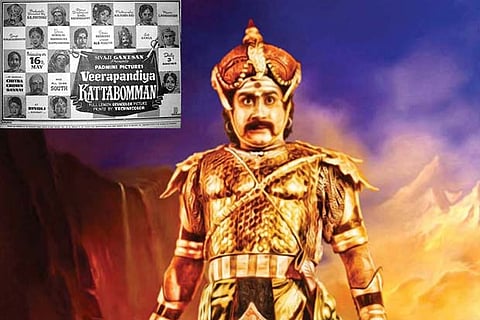

Chennai
‘The skies pour and the fields yield...Why would I pay a tax to you?’ Was this the most recognised piece of oration Tamil history actually ever spoken?
Kattabomman, the Palayakarrar of Panchalankurichi who spoke them (and received a noose around his neck as a reward), was of Telugu descent. In fact, NTR himself spoke the Telugu version in a movie later.
Historians believe that these lines came into prominence 150 years after Kattabomman’s demise through books, theatre and finally were immortalised by Shivaji Ganesan’s film Veerapandiya Kattabomman that released in 1959.
Traditionally, Madras’ armies had quelled other freedom movements. But when Independence neared, there was a great patriotic fervour and Madras needed historical stories of freedom fighters.
Kattabomman was executed in 1799 but was not forgotten. Goats were regularly sacrificed near the tamarind tree where he was hanged. And at the site of his demolished fort, travellers religiously kept stones as a homage. Street plays were performed regularly in Kattabomman’s memory for over a century. During his childhood, Ganesan watched a street play called Kambalaththaarkoothu. Inspired by the play, he decided to become an actor — it changed Ganesan’s fate and that of Kattabomman’s as well.
Inspired by a line in a Kothamangalam Subbu’s song from the Gemini film Miss Malini, Ma Po Sivagnana Gramani wrote a biography of Veerapandiya Kattabomman called Veerapandiya Kattabomman. The story of Miss Malini was written by RK Narayan. In a song from Miss Malini, Subbu mentions Kattabomman along with Mahatma Gandhi and Subhas Chandra Bose (Gandhi Mahaan, Netaji, Kattabomman kathai koori).
In 1948, Selvam Pictures announced Kattabommu, a mammoth production with PU Chinnappa. In 1953, Gemini Vasan tried to pre-empt others by issuing a promotional newspaper advertisement.
TKS Brothers brought Kattabomman to the stage as Muthal Muzhakkam (the first cry/call), but the audience response was lukewarm. One day, Sivaji Ganesan along with scriptwriter Sakthi Krishnaswamy was travelling through Kayatharu, the place where Kattabomman was hanged. Sivaji, perhaps, reminded of his life inspiring childhood experience, suggested a play based on the life of Kattabomman. Sakthi wrote it in a month’s time — it was launched in Salem in August 1957. The team invested close to Rs 50,000 for sets and costumes. The play successfully ran 112 shows.
Producer BR Panthulu, who specialised, in histories and mythologies, decided to make it into a movie. Panthulu and Sivaji were not sure how close Gemini was to making the movie did not want to challenge the giant. Sivaji swallowed his pride (he had once been rejected by Vasan for a small role in Chandralekha) went over to Gemini to request Vasan to keep away. Vasan handed over the material he had collected for the script.
It was then the opposition strengthened. The government was projecting the 1857 Sepoy Mutiny, as the first war of Independence could not stomach the fact that there were earlier movements; especially, with the centenary around the corner.
Bestselling detective fiction writer Tamilvanan wrote a book Kattabomman Kollaikaran mentioning that Kattabomman’s achievements were dubious and that he was actually a bandit. Poet Kannadasan went one step ahead and stated that the Maruthu Pandiyars were the real freedom fighters. He made a film about them — Sivagangai Seemai. And the two films clashed in the box office. Kannadasan went into debt after this film flopped.
Veerapandiya Kattabomman that was shot in technicolour, a first for a Tamil film (the lighting being sizable, actors came out of the sets in tears), had its premiere, ironically, in London in 1959. High production costs nullified the successful theatrical run of 175 days.
It was dubbed in Telugu as Veerapandiya Kattabrahmanna where Kattabomman spoke in his mother tongue. At the 1960 Cairo Afro-Asian Film Festival, Sivaji received the best actor award from President Nasser. MG Ramachandran, the president of the South Indian Actors Guild, organised a huge reception in Chennai to welcome him. A decade later, Ganesan made a statue of Kattabomman at Kayatharu.
The breath-taking performance of Sivaji Ganesan changed the perception of Kattabomman. He is still a favourite for school fancy dress competitions!
Historians contradict the depth of his patriotism and bravery and experts say there was a lot of confusion between history and folklore, but Kattabomman stays as the greatest freedom fighter of the Tamil soil.
— The writer is a historian and an author
Visit news.dtnext.in to explore our interactive epaper!
Download the DT Next app for more exciting features!
Click here for iOS
Click here for Android